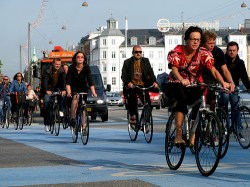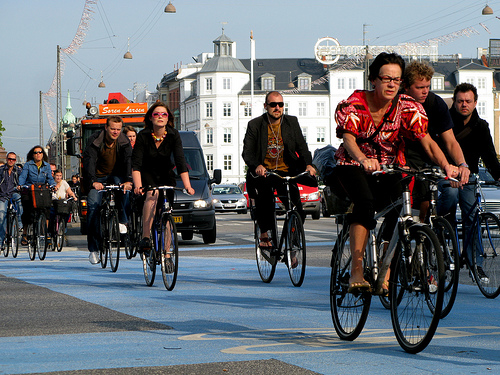
Living the dream in Copenhagen. (Photo by Mikael Colville Andersen.)
Once was that American cities competed to look more like Detroit, with gleaming lanes of highway stretching as far as the eye could see. Any more, it’s a race to imitate Copenhagen, the Danish capital where 36 percent of residents commute to work via bicycle.
So it seems, at least, when looking at today’s announcement by the League of American Bicyclists of the latest — and largest — round of official Bicycle Friendly Communities in the U.S. Some of the cities on the list will come as no surprise: Portland, San Francisco, and Chicago are here, as is Missoula, Mont., where 7 percent of residents bike to work, versus the 0.6 percent national average. But so are cities like Baltimore, Cincinnati, and Cottonwood, Ariz. Twenty-five more cities applied for bicycle-friendly status, but were denied.
The league hands down its Bicycle Friendly certification with a multi-tier, Olympics-like grading system: Cities can earn bronze, silver, gold, and platinum. The awards, which have been around since 1996, recognize cities that both promote cycling as a means of transportation and actively work to make cycling safer. A panel of national experts brought in by the league and local enthusiasts (bike shop owners, advocacy group leaders) assesses applications along five main criteria: engineering, education, encouragement, evaluation and planning, and enforcement.
The best cities, League of American Bicyclists President Andy Clarke says, have action plans in place to ensure that residents have opportunities to ride. They have city-sponsored bike rides, and networks of bike trails, lanes, and sharrows that connect them to where they need to go.
Louisville, Ky., is one city that’s done what Clarke advocates. In 2005, then-Mayor Jerry Abramson held the city’s first bike summit and vowed to make Louisville a gold-level Bicycle Friendly City by 2015. The city then set up bike facilities at traffic-heavy locations downtown, installed eight miles of striped cycling lanes, hosted community rides on Memorial Day and Labor Day, and raised $20,000 for bike education classes in 2006. In 2007, the city earned bronze-level certification one year ahead of schedule, and continues its cycling advocacy today.
Clarke says many of the winners are beneficiaries of some sort of cycling crusader or organization pushing hard for reforms, enforcement, and acknowledgment of bikers. “Having a champion like a mayor or city councilperson who set outs measurable targets and goals that you can hold yourself accountable to — that seems to make the biggest difference,” Clarke says.
One sticking point for the league is measuring how well local police enforce laws designed to protect cyclists. A recent study [PDF] conducted by Johns Hopkins University researchers found that cyclists in bronze-level certified Baltimore are routinely passed by vehicles traveling within the three-feet buffer mandated by law.
And while the latest round of awards is music to many bikers’ ears, “I will be the first to admit we have a long, long way to go,” says Clarke. Even Portland, Ore., which gets a platinum certification from the league, “would be a pretty crappy Dutch city when it comes to cycling,” Clarke says.


